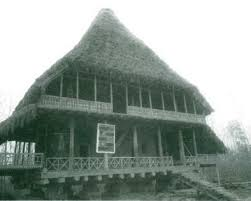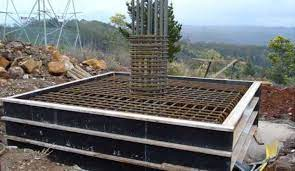What Grillage Foundation?
Grillage foundations are made of one, two, or more levels of beams (usual steel) superimposed on a layer of concrete to distribute load across a large area. It is found at the bottom of the columns. These layers are concrete-encased and at right angles to one another. This foundation form commonly supports heavy building columns, piers, and scaffolds.
Even though foundation and grillage appear to be the same, they are not. Grillage disperses huge loads across broad areas, similar to how foundations distribute the load from the structure to the ground.
Uses of Grillage Foundation:
- Grillage foundation is utilized when hard rock soil is unavailable, and mat foundation is not an option.
- Deep excavations are not required for grillage foundations. As a result, it is cost-effective.
- A grillage foundation allows for the safe transfer of heavy building loads.
- The grillage foundation is employed in the main project for an electrical transmission line and the foundation for a telephone tower.
Design of Grillage Foundation:
The loads and moments from the superstructure calculate for the grillage foundation design. Based on this, the critical foundation area for a sufficient allowed ground bearing pressure must be determined. We’ll divide this space to determine the number and size of each grillage layer.
The layer must then be designed to cantilevers from the edge of the layer above it. It will determine how big the beams need to withstand the bending moments and shear forces. The grillage cannot be encased in concrete and the order since this would demoralize the composite action of the beam and concrete. The construction and loading methods must be compliant with the design requirements.
Features of Grillage Foundation:
- This foundation is usually constructed as a monolithic reinforced concrete structure. The metallic framework provides the resistance (steel foundation for grilling)
- The grill joins the entire foundation to the single structure, ensuring that the weight of the house and all the piles are distributed evenly.
- Between the grillage beams, a minimum gap of 800 mm is provided to allow for easy pouring and compacting of the concrete.
- The concrete depth beneath the lower tier is kept to 150mm.
- The concrete filler holds the beams in place and prevents rusting because it does not carry a load.
Installation of the Grillage Foundation:
- The framework for solid monolithic grillage must be built and installed.
- The formwork comprises rectangular troughs made of edging boards, with a width equal to the house’s minimum wall thickness and 1 ft.
- The minimum distance between the frame and the side of the formwork must be the same, and the reinforcement must be linked with the same binding wire.
- A 6 to 8-inch space between each grillage must be established, and a framework of reinforcement connections must be established inside the formwork using binding wire.
- Next, concrete must be made with the cement mixer and put into the formwork in a continuous cycle. Grillage foundation fitting should be installed at around 25mm to 30mm, and concrete should be carefully poured to eliminate voids.
- After filling the surface, it must be leveled and allowed to cure, after which the formwork can be removed. The foundation has been laid.
Types of Grillage Foundation:
1. Timber Grillage Foundation:
A timber-type foundation is supplied for strongly heavy masonry walls of timber columns. This foundation is particularly effective in wet areas where the soil’s bearing ability is low, and the weight on the soil is limited to 50-60 KN/m2. Steel joists are replaced with timber planks and beams.

Fig 1: Timber Grillage Foundation
Courtesy: researchgate.net
Between the timber joints, no concrete is present. However, the steel grillage’s bottom concrete is replaced by a timber platform made of wood boards. The base excavation has been leveled. The bottom layer comprises 20-30cm wide, 5-7.5cm thick timber boards set side by side with no gaps.
A timber beam of the same section as the wooden post is installed at right angles on this layer. Then, at right angles to the path of the beams, another layer of boards is laid. The top layer of planks could be 7.5-10 cm thick. Thick and spanning the entire width of the wall base, over which a masonry wall is built.
1. Steel Grillage Foundation:
Steel grillage foundation consists of steel beams, also known as grillage beams, offered in single or double levels. The upper tier of a double-layer grillage foundation is built at right angles to the lower tier. 20 mm spacer bars with 25 mm diameter pipe separators hold the grillage beams of each tier in place. The beams are spaced enough apart to allow for the placement and compacting of concrete between them. A minimum clearance of 8 cm is deemed most optimal. The space between the beams’ flanges should be one and a half to two times the flange width, with a maximum of 30 cm.

Fig 2: Steel Grillage Foundation
Courtesy: civicconcept.com
If the beams are placed further apart, there is a risk that the concrete filling will not operate monolithically with the beams, resulting in the foundation failing. A minimum cover of 10 cm is preserved on the outside edges of the external beam. Above the top tier’s upper flange to protect the beams from corrosion. Under the lower beam, the concrete cover should not be less than 15 cm thick.
Advantages of Grillage Foundation:
- It takes less time to install and uses fewer resources.
- It lowers heat transfer from the home via the foundation because it is not sprayed on frozen earth.
- It reduces the amount of vibration in the house (it is very real if the house is built close to highways).
- Installation of Grillage Beams takes less time and requires fewer resources.
- This type of foundation may sustain significant structures like column piers and scaffolds.
- It can spread the weight across a larger area.
Disadvantages of Grillage Foundation:
- This foundation required the insertion of large-diameter piles.
- It is necessary to heat and fill the empty area between steel beams. As a result, skilled personnel are needed.
- The excavation of a bigger area is required to construct a grillage foundation, which increases the construction cost.
- This type of foundation is susceptible to uplift pressure.
- The structural arrangement of the column bed is subject to modification in grillage foundation construction at times.
Conclusion:
For huge expanses, grillage foundations are commonly used instead of poured concrete. Because of the straightforward installation process, the grillage foundation saves time. The grillage foundation constructs to meet a variety of construction needs. As a result, grillage foundations are suited for various construction applications.
References:
1. Mahajan, B. (2021, June 17). Grillage Foundation | Types Of Grillage Foundation | Steel Grillage Foundation | Grillage Footing. Civiconcepts; civiconcepts.com. https://civiconcepts.com/blog/grillage-foundation
2. Lead, C. (2020, November 12). Grillage Foundation – Types, Advantages & Disadvantages – Civil Lead. Civil Lead; www.civillead.com. https://www.civillead.com/grillage-foundation/
3. Rajput, K. (2021, August 21). Grillage Foundation | Types of Grillage Foundation | Features of Grillage Foundation. CivilJungle; civiljungle.com. https://civiljungle.com/grillage-foundation/
4. Satheesh. (2020, May 11). Grillage Foundation – Types & Installation [Civil Planets]. Civil Planets; civilplanets.com. https://civilplanets.com/grillage-foundation/
5. Grillage Foundation: Types, Construction, and Advantages – The Constructor. (2022, January 13). The Constructor; theconstructor.org. https://theconstructor.org/building/grillage-foundation-types-construction/560853/
6. What is Grillage Foundation? Construction and Advantages. (n.d.). PRODYOGI; www.prodyogi.com. Retrieved March 18, 2022, from https://www.prodyogi.com/2021/03/what-is-grillage-foundation.html
If you have a query, you can ask a question here.


